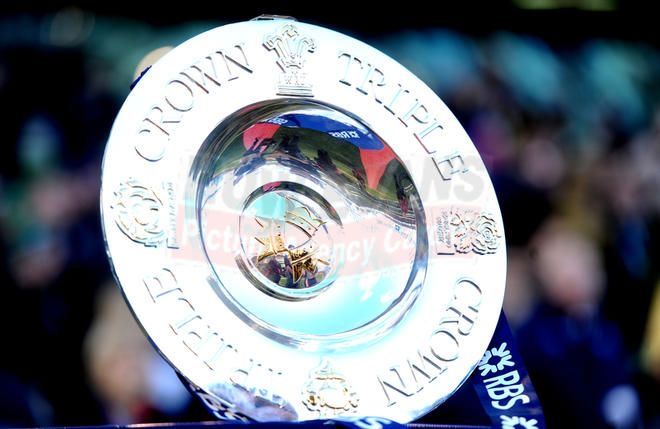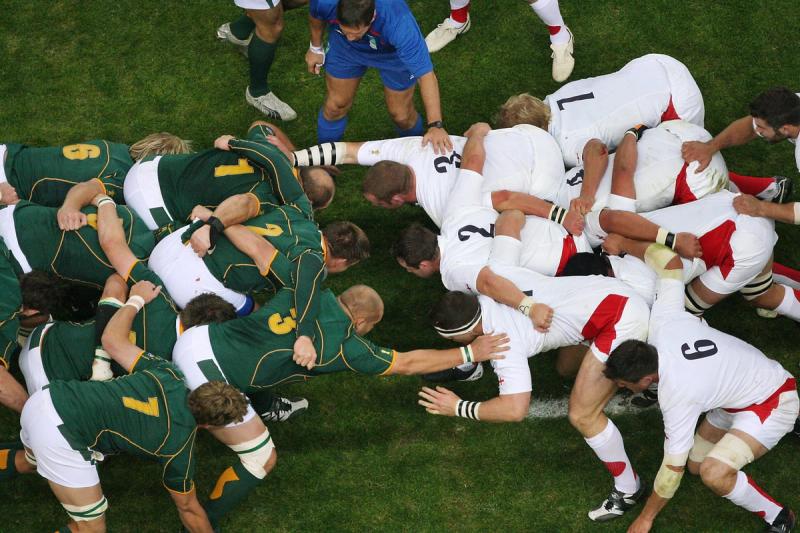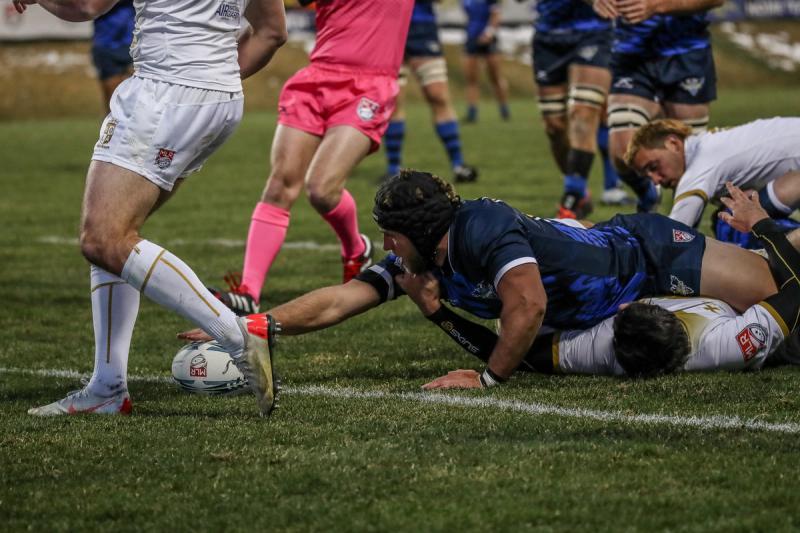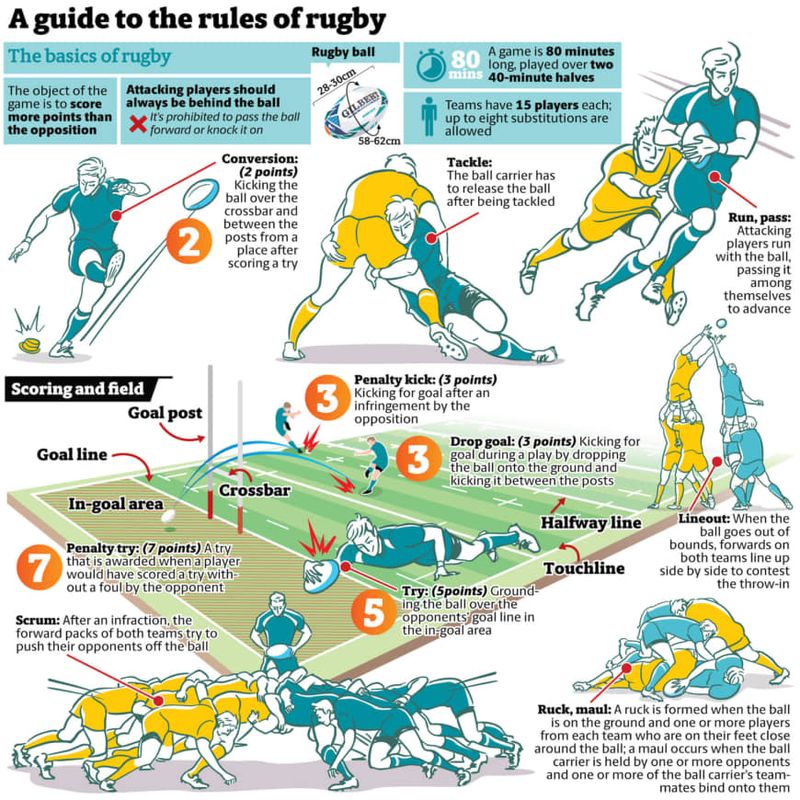Introduction
Rugby is a sport known for its physicality, teamwork, and diverse player positions, each with unique roles and responsibilities on the field. For newcomers to the game, understanding these positions can seem daunting, but this beginner's guide will break it down, position by position, to provide a clear understanding of who does what on the rugby pitch. Want to get a head start on the slang surrounding Rugby? Dive head-first into our Rugby Vocabulary Article.
The Rugby Team Structure
A rugby team consists of 15 players, divided into two main groups: forwards and backs. Each group has distinct roles and contributes to the team's success in different ways.
Forwards
- Props (Jersey Numbers 1 and 3): The props are the anchor of the scrum, which is a critical set-piece in rugby. They provide stability and power during scrums, ensuring that the team retains possession of the ball. Props are also involved in rucks and mauls, providing physicality and support.
- Hooker (Jersey Number 2): The hooker's primary role is to throw the ball into lineouts accurately. They also play a vital part in the scrum, as their job is to hook the ball back to their team. Hookers need a combination of strength and accuracy in their throws.
- Locks (Jersey Numbers 4 and 5): Locks are tall players who provide stability in the scrum and play a crucial role in lineouts. They often act as "jumpers" during lineouts, leaping to catch the thrown ball, and they are also significant contributors in rucks and mauls.
- Flankers (Jersey Numbers 6 and 7): Flankers are versatile players who are involved in open play, tackling, and securing the ball at rucks. They are known for their agility and ability to cover ground quickly. Flankers are often key players in turnovers and ball retention.
- Number Eight (Jersey Number 8): The number eight often positions themselves at the back of the scrum and serves as a link between the forwards and backs. They provide a strong running presence and can carry the ball effectively, making them valuable in both attack and defense.
Backs
- Scrum-half (Jersey Number 9): The scrum-half is the playmaker in the backs. They are responsible for distributing the ball from the base of scrums and rucks to the backs, allowing for quick and accurate passing to set up attacks. They also provide support in defense.
- Fly-half (Jersey Number 10): The fly-half is often considered the team's tactical leader and playmaker. They make crucial decisions, including when to pass, kick, or run with the ball. Fly-halves are also responsible for kicking for territory and goal kicking.
- Centers (Jersey Numbers 12 and 13): The centers are versatile players who are involved in both attack and defense. The inside center (12) often acts as a distributor and crash ball runner, while the outside center (13) is typically the faster of the two and focuses on creating opportunities for the team.
- Wingers (Jersey Numbers 11 and 14): Wingers are known for their speed and agility. Their primary role is to finish tries by running down the sidelines with the ball. They also play a part in kick returns and providing support in defense.
- Full-back (Jersey Number 15): The full-back is the last line of defense and serves as the team's last resort in preventing the opposition from scoring. They also play a role in catching high kicks and launching counter-attacks.
Now that we've covered the basics of each position let's dive deeper into what each role entails:
Forward Positions
Props (Jersey Numbers 1 and 3)
The props, often referred to as the "bookends," are positioned on both sides of the front row during scrums. Their primary responsibilities include:
- Providing stability and power during scrums.
- Hooking the ball back in the scrum to secure possession.
- Engaging in rucks and mauls to support their teammates.
- Tackling and providing physicality in open play.
Props are typically strong, heavyset players who can hold their ground in the scrum and contribute to the physical aspects of the game.
Hooker (Jersey Number 2)
The hooker has a specialized role in the forward pack, with key duties that include:
- Accurately throwing the ball into lineouts to target jumpers.
- Hooking the ball back in the scrum, ensuring clean and quick ball distribution.
- Supporting the team in the lineout as a jumper or lifter.
- Engaging in rucks and mauls, contributing to ball retention and turnovers.
Hookers need to have a strong throwing arm, agility, and the ability to hold their position in the scrum.
Locks (Jersey Numbers 4 and 5)
Locks, also known as second rows, have essential roles that involve:
- Providing stability and power in scrums, ensuring a solid platform for the team.
- Acting as primary jumpers in lineouts, aiming to secure possession.
- Engaging in rucks and mauls, using their strength and height to contribute to ball retention and turnovers.
- Tackling and providing support in open play.
Locks are typically tall and powerful players who play a significant role in both set pieces and open play.
Flankers (Jersey Numbers 6 and 7)
Flankers are versatile forwards known for their speed and agility. Their responsibilities include:
- Being involved in open play, covering ground quickly, and contributing to both attack and defense.
- Tackling opposing players and securing turnovers during rucks and mauls.
- Supporting the team in lineouts when needed.
- Providing a link between the forwards and backs.
Flankers are often the team's "fetchers," adept at winning possession back from the opposition.
Number Eight (Jersey Number 8)
The number eight, positioned at the back of the scrum, plays a crucial role in the forward pack, including:
- Acting as a ball-carrying force in both attack and defense, making ground through powerful runs.
- Supporting the scrum by maintaining stability at the back.
- Engaging in rucks and mauls, securing possession and disrupting the opposition's efforts.
Number eights are often known for their ball-carrying abilities and their importance in gaining territory.
Back Positions
Scrum-half (Jersey Number 9)
The scrum-half is a pivotal player in the backline, responsible for:
- Distributing the ball quickly and accurately from the base of scrums and rucks to initiate attacks.
- Providing support for the fly-half and backs in orchestrating plays.
- Engaging in tactical kicking, including box kicks to gain territory.
- Participating in defensive plays and providing quick delivery for clearing kicks.
The scrum-half is often regarded as the team's playmaker in the backline.
Fly-half (Jersey Number 10)
The fly-half, often considered the team's tactical leader, has diverse responsibilities:
- Making crucial decisions during matches, including when to pass, kick, or run with the ball.
- Directing the team's strategy and orchestrating plays with the backs.
- Kicking for territory and goal kicking when opportunities arise.
- Offering a strong defensive presence and supporting the backline.
Fly-halves are known for their strategic thinking and ability to read the game.
Centers (Jersey Numbers 12 and 13)
The centers are versatile players in the backline, each with their specific roles:
- Inside Center (Number 12): The inside center often acts as a distributor, providing key passes and acting as a crash ball runner in attack. They require a strong understanding of both attack and defense.
- Outside Center (Number 13): The outside center is usually the faster of the two and focuses on creating opportunities for the team. They aim to break through the opposing defense with speed and agility.
Centers work closely together to form a solid midfield partnership, contributing to both attack and defense.
Wingers (Jersey Numbers 11 and 14)
Wingers are positioned on the edges of the backline and have specific responsibilities:
- Finishing Tries: Wingers are known for their speed and agility, and their primary role is to finish tries by running down the sideline with the ball.
- Fielding High Kicks: Wingers are often responsible for catching high kicks and initiating counter-attacks.
- Providing Defensive Support: Wingers also play a role in supporting the full-back and covering the defensive line.
Wingers are often the players who score spectacular tries through their pace and skill.
Full-back (Jersey Number 15)
The full-back is the last line of defense and plays a pivotal role in the backline, with responsibilities that include:
- Preventing the opposition from scoring tries by making crucial tackles and positional plays.
- Fielding high kicks, including clearing kicks from the opposition or kick returns.
- Launching counter-attacks when opportunities arise, using their vision and speed to exploit gaps in the opposition's defense.
Full-backs require excellent spatial awareness and the ability to read the game effectively.
Player Roles in Action
Understanding the roles of each position is crucial, but the beauty of rugby is that every player must be versatile and contribute in both attack and defense. Teamwork and communication among players, regardless of their positions, are key to success.
Let's look at how these roles come together during a typical rugby match:
- Forwards: The forwards engage in the physical aspects of the game, such as scrums, lineouts, and rucks, to secure possession and create opportunities for the backs.
- Scrum-Half and Fly-Half: The scrum-half and fly-half work in tandem to set up plays and execute tactical kicks, ensuring a smooth transition between the forwards and backs.
- Centers: The centers create attacking opportunities by breaking through the defense or distributing the ball to wingers and the full-back.
- Wingers and Full-Back: Wingers utilize their speed to finish tries, while the full-back provides a solid last line of defense.
The game of rugby relies on cohesive teamwork, with each player executing their role effectively to achieve success. Understanding these roles is the first step toward becoming a well-rounded rugby player and enjoying the sport to its fullest.
Conclusion
Rugby is a sport that values both individual skill and collective teamwork. Every position on the field has its unique role and responsibilities, contributing to the team's overall performance. Whether you're a newcomer to rugby or a fan looking to deepen your understanding of the game, this beginner's guide to player positions serves as a solid foundation. The next time you watch a rugby match, you'll have a clearer perspective on the roles of each player and a deeper appreciation for the intricacies of this exhilarating sport.
Need a more indepth guide? Check out our comprehensive guide to Rugby!
Related posts
See all
February 23rd
The Evolution of Rugby Tactics: Top 5 Innovations That Changed the Game
Discover the dynamic evolution of rugby tactics through the top 5 innovations that reshaped the game. From the introduction of set plays to the embrace of data analytics, rugby's strategic landscape has evolved dramatically. These innovations reflect a relentless pursuit of excellence and a commitm...

February 20th
Total Rugby: Embracing the Essence of Dynamic Play
Total Rugby, born from Fred Allen's vision, revolutionized rugby with its fluidity and creativity. Encouraging unstructured play, it empowered players to adapt and express themselves freely on the field. Its legacy extends globally, inspiring teams to embrace versatility and innovation. Total Rugby ...

January 4th
Triple Crown Triumph: Rugby's Prestigious Trophy
The Triple Crown, steeped in rugby lore, transcends sport as a symbol of excellence and national pride. From its origins in the late 19th century to the modern era's dynamic clashes.

November 19th
Evolution of Rugby: From Inception to Modern-day Mastery
Unveil the evolution, triumphs, and challenges that define rugby's unparalleled journey—a testament to the enduring spirit that has shaped it into a worldwide phenomenon.

November 9th
Scrums and Lineouts Demystified: Rugby Basics
Rugby's scrums and lineouts, often seen as intricate components, are pivotal in the sport's dynamics.

November 6th
Rugby Basics: A Step-by-Step Guide to Scoring a Try
Scoring a try in rugby is a thrilling culmination of teamwork, strategy, and skill. It involves grounding the ball with downward pressure in the opponent's in-goal area, worth five points.
